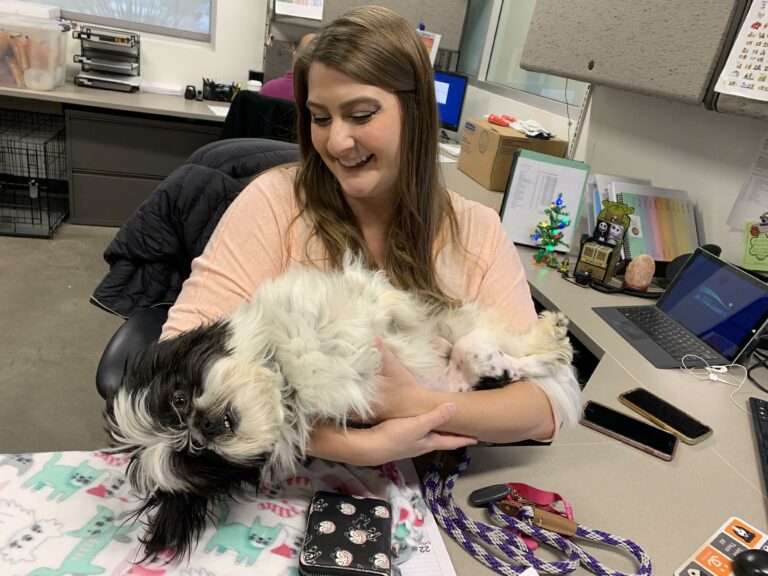Human Animal Support Services (HASS) just put out a brand new resource: Integrating Veterinary Social Work Into Animal Shelters. It gets into what veterinary social workers do, ways they can support people and pets in the community and support shelter staff—and how shelters can hire a veterinary social worker full time, or access their services for community and staff.
This gives us the perfect opportunity to talk with Kelly Bremken, who became a veterinary social worker after working in animal welfare for over 15 years. Kelly came on staff at the Oregon Humane Society in Portland, Oregon, last October.
Kelly is part of a burgeoning new field, and one of the first people ever to hold this specific position at a shelter. She’s also a member of the Human Animal Support Services working group that created the new HASS veterinary social work resource!
We were eager to hear about what Kelly’s job entails, what she does for people and pets in this role, ideas for other animal organizations, and so much more! We got chatty; this Q&A has been edited for space.
HASS: What exactly does a veterinary social worker do? And especially what does a veterinary social worker who works for a shelter do?
Kelly: Veterinary social work is sort of new, but coming on strong. Some people work in academics or in veterinary hospitals or emergency clinics. I’m really excited about the work in the animal shelter because it marries the animal welfare part with the people part.
I spend part of my time with clients helping them do things like access resources, find food banks, use the resources that the Oregon Humane Society has always had on their website.
It’s just helping them solve problems to get those resources. For example, transportation’s a huge barrier. I can give you a list of all the food banks in our area, but if they’re not within walking distance to you and you don’t own a car, So we figured out, does our organization, like other social services, need to purchase bus tickets to have on hand for clients who cannot afford the bus, but could ride the bus? So now we have bus tickets.
It’s helping people drill down to find the barrier for that service and then help them solve that problem. Because, they’re solving it themselves. I’m just the one talking them through it.
We end up with people who are relinquishing a pet for multiple reasons like going into drug and alcohol treatment or going in for mental health treatment that requires inpatient care. For some of those people, I can help them find temporary housing for their animal.
I also work with other social service agencies within my community. For example, there are elder care or senior centers that have clients with pets, and they’re looking for access to low cost vet care, or they’re looking for food bank options for their clients who are on fixed incomes.
It’s about connecting other social services with things that are already happening. It just, maybe, isn’t their area, so they don’t know where to look. We’re building those professional relationships.
And then the last part is my favorite part, which is staff. I’m part of our staff wellness. I am available to talk to staff, to debrief really difficult situations that they go through at work. And any changes that we’re having.
There’s a quote that we use all the time in our meetings, that says working in animal welfare and not absorbing the trauma is like the idea that I could walk through water and not get wet. I think it’s really important to normalize that idea that you can be passionate about this job and love this job, and also know that this job is really difficult.
I was that staff member who worked in foster care, who worked 10 hour days, and who would talk to families about kittens that didn’t make it through the night. Then I would think, why can’t I sleep tonight? Or gosh, why am I so upset about this one kitten when there were seven that died this week? I just didn’t understand the toll that the work was taking.
I think that’s why I love the staff work so much. I also think it’s why staff will trust me and talk to me. I think that them looking across the table and seeing some spark of recognition and understanding, I know what it’s like.
When I got hired, I was like, I need a budget that includes good candy. And everyone laughed. I was like, it’s not a joke. I need good candy in my office so that people will stop by “for the candy.” And everyone was like, okay, you can always have good candy.
I also think that having the staff know that I’m there and that the whole place is committed to their wellbeing—I think that’s so important for staff to know.
HASS: Can you tell me about some of the people and pets who you’ve worked with?
Kelly: Our admissions team got a call. A woman needed to relinquish a cat because of litter box use.
This person said, “Hey, I live in government housing. I have a Section 8 voucher, and one of the stipulations of having Section 8 housing is that you have to keep your apartment clean. And if your landlord decides it’s not clean, they can actually ask you to move.”
I got involved because it was a housing issue, and we were trying to keep this person and pet together. Turns out this person had had a physical limitation that they couldn’t scoop the litter box.
They had a home health aid, but that home health aid was not able to scoop the litter box. They weren’t a cat person. So I reached out to the local housing authority and that local housing person said, “I’d really love to help this person. I have 135 clients and it’s a lot and I don’t know of any resources.”
I looked around and I found a pilot project from another group in town that was offering to help with dog walks and pet cleaning for people who were housebound. And that group was able to go in and help with the litter box.
That was good enough for the landlord for that person to keep their housing. So, number one, that person got to keep their housing, but also that person got to keep their pet, which was very important to her.
She was able to keep her pet. That pet was able to be cared for. And once the litter box was clean and we had our behavior team go through some common litter box issues, we were able to get that cat using the litter box again and keep that family together.
I like that example because it didn’t just take me, right? By myself, I certainly orchestrated things, but at the same time, I didn’t spend time on the phone with this person. That was our training and behavior team, helping them work through what litter box problems looked like.
And the home health aid was able to help in the end, because the other pilot project group, those volunteers, showed the home health aid how to scoop the litter box. So I didn’t physically do that work, but setting it all up is the thing that I like the most about it. You get to orchestrate those things and connect all those dots.
It’s giving these situations time and space so that we can figure out what is the actual solution. And I get to orchestrate a lot of it.
It’s just this amazing idea that we’re only limited at this point by what we think our limitations are.
HASS: For the shelters that don’t yet have a veterinary social worker on staff, or don’t have funding for a veterinary social worker, what are you doing that they could absorb into their practices? How can others do what you are doing?
Kelly: I think that lots of shelters are already doing the work. They’re calling it community engagement, they’re calling it outreach. So the work is already being done.
I think it’s important for them to give themselves grace and reflect upon the things they’re already doing, which are very successful.
The things that we recommend in the toolkit are reaching out to other social service workers, other social workers, maybe medical or hospice resources in your area, maybe training from within your organization.
There are veterinary social work consultants around. The University of Tennessee has information on their website for how to find a veterinary social worker. They also have a program where you can access a veterinary social worker if you need that support. So it’s out there, it’s small and budding and gearing up, but it’s definitely happening.
HASS: Do you find yourself dealing with the potential of burnout and compassion fatigue in this role? Or do you find that in this role, you are a little bit more shielded from those things?
Kelly: Great question. I don’t feel shielded from those things. Compassion fatigue and burnout, and boundary work are part of my everyday work for myself. Well, first of all, I have a mentor for supervision because I’m working on my licensure. So that’s someone that I’m able to talk to.
And then I also have my own mental health therapist. I see my counselor to talk about my own life, which does include so much work for me. And then it really becomes this idea that I want to be leading by example for staff.
I’m around anytime you need me during work hours. But as soon as 5:30 rolls around, I turn into a pumpkin and that’s a boundary I like to carry really hard. But it is still a struggle even for me to feel like I’m succeeding at giving myself the space and time to process all the work.
HASS: So you have the tools and the language to think about these things, but it’s still hard to do in practice.
Kelly: Yeah. It’s having the language and having the tools, which is something I’m so grateful to be able to share with staff because there’s this idea, especially when you work with younger children or teenagers, we say all the time, you’ve got to name it to tame it.
It’s this idea that most people can’t name their own feelings or emotions, not just children. I wish it was just children, but also adults. And so it’s this idea to get you to… If I can give you the language to talk about it, we might be able to process or work through it. And so I do feel like I’ve got the tools to work through it, but it is still a process.
I don’t care how much training you’ve had or how much self care you succeed at. Talking to people about losing an animal, or that anticipatory grief of losing an animal to surrender or to euthanasia—that still sits with you and weighs heavy on our hearts. Because we love animals so much and because we love the people who love animals so much. I’m not immune to that.






